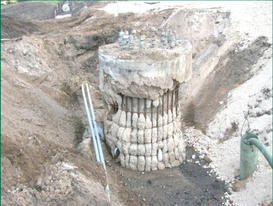|
What are Drilled Shafts?
Drilled shafts, also referred to as drilled piers, caissons or bored piles, are deep foundation solutions used to support structures with large axial and lateral loads by excavating cylindrical shafts into the ground and filling them with concrete. A drilled shaft is a type of deep foundation that is constructed in place by drilling a hole into the soil, often to bedrock or a hard stratum, and subsequently placing concrete in the hole. The concrete may or may not contain reinforcing steel. The purpose of a drilled shaft is to transmit a structural load to the shaft’s base, which may be bedrock or another hard stratum. In essence, a drilled shaft is primarily a compression member with an axial load applied at its top, a reaction at its bottom, and lateral support along its sides. Drilled shafts are constructed by using auger drill equipment to form a hole in the soil. Soil is removed from the hole during drilling, in contrast to the driven pile, which only compresses soil to the side. |
Drilled shafts are a popular type of deep foundation for several reasons. Drilling equipment is relatively light and easy to use compared to pile-driving equipment, resulting perhaps in lower construction costs. Also, drilling equipment is much quieter than pile drivers and does not cause massive ground vibrations, giving drilled shafts the advantage in areas near schools and hospitals. Lesser ground vibrations result in less adverse effects on adjacent piles. Another advantage of drilled shafts is that they can be drilled to greater depths through very dense soil and gravel. A drilled pier is constructed by drilling a cylindrical hole of the required depth and subsequently filling it with concrete. The shaft may be straight or the base may be enlarged by under-reaming. The term "caisson" is also used to describe large prefabricated box-type structures that can be sunk through soft ground or water at a site to provide a dry work space. |
|
Advantages of Drilled Piers
|


